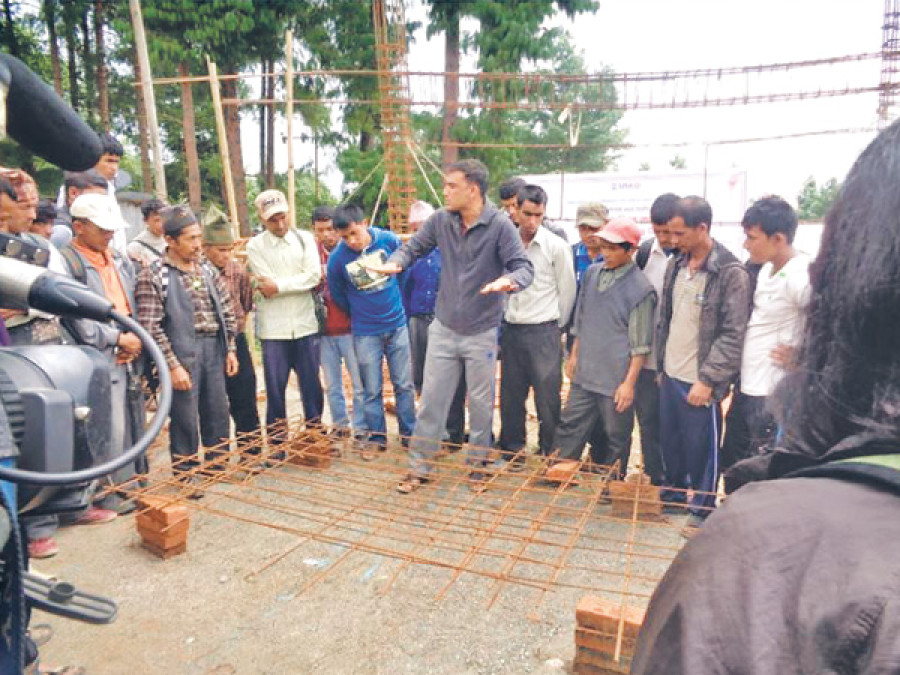Opinion
Training for development
Decades-long donor-funded and I/NGOs-driven disaster risk reduction programmes may not be trusted
Gyanendra Gurung
When the Gorkha earthquake rattled Kathmandu, the shaking was moderate despite the high magnitude of the tremor and its proximity to the epicentre. The devastation in the city was surprisingly not as catastrophic as expected, which led national (and international) experts to argue that engineers and masons trained in earthquake-resistant construction methods over the past several decades had somehow contributed towards such a ‘positive effect’. However, they did go on to add that the devastation could have been further lessened had Nepali engineers been provided with more training. Thus, in the immediate aftermath of the earthquake, I/NGOs were quick to jump onto the ‘lack-of-training’ bandwagon and conducted several trainings on earthquake-resistant technology for engineers and masons alike. While the trainings for skilled and semi-skilled labour are justified (and much needed), the argument that professional engineers need to be trained is baffling. Does such a proposition not demean the quality of engineering education in Nepal?
Bad image
Many of us who have worked with engineers educated in Nepal can agree that the undergraduate and graduate engineering curriculum taught at Institute of Engineering of Tribhuvan University and other engineering colleges are highly competitive and on par with any other engineering schools in western nations. In truth, a Bachelors Degree in Engineering is sufficient enough to conduct quality construction, monitoring, and supervision of designs prepared by senior structural engineers. And if current students were to further work under the aegis of a professional engineer for several years, they would have accumulated enough experience to be well-versed in seismic-resistance methods and other geotechnical aspects of engineering to build robust infrastructures. Thus, there is no reason to doubt the quality of Nepali engineering education.
However, when pseudo-scientific I/NGOs—with funds funnelled from international donors—provide trainings to Nepali engineers on earthquake-proofing techniques under the pretext of ‘lack of training’, it belittles the quality of engineering education in Nepal. It certainly does not present our engineers favourably in the eyes of the international community and public alike. Unless these trainings impart advanced knowledge on construction methods or newly-invented geotechnical stability methods, they will be unnecessary and utterly redundant. If donors are truly concerned about the country’s welfare, then maybe they should cut loose their beloved I/NGOs and instead appropriate generous amount of their funds directly to long-term sponsorships of innovative engineering research projects within our own engineering institutions. While this might sound fantastical, would it not be wonderful if somehow much of the ‘development’ aid were in fact used to fuel a revolution in scientific research and innovation in developing countries?
After all, these are the bastions of ‘actual’ development.
Nevertheless, coming back to trainings, we have to remember that such trainings for engineers were conducted regularly in the past. And they certainly tainted Nepali engineers as ‘inefficient’ in comparison to international engineers. If we look back at the immediate aftermath of the Gorkha earthquake, we can remember many instances where engineers faced much ridicule. Obviously, when many parts of the city turned to heaps of rubbles, the public began to question the know-how of all experts alike. And later, when it was revealed that some engineers had carelessly overlooked the nationally-mandated construction guidelines in their design, the angry public naturally sharpened their pitchforks. So, can more trainings—like the ones in the past—ensure earthquake-safe constructions in
the future?
Code of ethics
Nepal had already developed a strict set of rules for safer building practices back in 1994. It is called the National Building Code (NBC) and we were only recently acquainted with it when it was updated. But, as with all rules and regulations, their implementation remains the Achilles heel. So, maybe a professional authority such as the Nepal Engineering Council should administer stringent criteria while granting ‘professional license’ to fresh engineers. Maybe the Council should not issue licenses to engineers unless they obtain a minimum work experience under the supervision of a registered professional engineer. But most importantly, the Council should take necessary measures to filter out engineers who do not adhere to the engineer’s strict code of ethics and the NBC. We have to make sure that under no circumstances will licensed engineers give into the misguided proposals of clients wanting to cut corners and insist on tweaking engineering plans to save some money. The Council should make sure that engineers are scrupulous and refrain from all actions that may jeopardise both the strength of engineering infrastructures and safety of the public.
Vocational trainings
So, if trainings are to be given, then they should instead be given to semi-skilled and skilled labourers. The current trainings for masons on earthquake-resistant building in the villages and cities alike are highly beneficial and the right step forward towards a resilient society. However, spending millions of dollars over a few years on training programmes in a few select districts is certainly not going to help ‘build back better’. Moreover, if these programmes are to meet their goal of an ‘earthquake-safe community’ within the next five years, then such vocational trainings need to be included in the national vocational curriculum.The Council for Techincal Education and Vocation Training (CTEVT), which is currently involved in many of these training programmes, should include such programmes within their broad and diverse curriculum.
The CTEVT, founded in 1989 is a glorious institution with an impressive list of affiliations and several technical schools throughout the nation. Since it has a large network throughout the nation, it might be the perfect body to recruit each and every skilled and semi-skilled labourers in the country and train them. So, maybe the donors should take advantage of CTEVT’s unique position and wider outreach and develop a multitude of integrated coursework to cover all aspects of earthquake-resistant technology and thus enable the production of well-trained workforce throughout the country, instead of in a few select districts.
The current training programmes are merely a band-aid solution to a much bigger problem. Furthermore, will these trainings better prepare us for the next big one? If we are to judge the effectiveness of our decades-long history of donor-funded and I/NGOs-driven disaster risk reduction (DRR) programmes and iniatives in Nepal in light of the recent Gorkha earthquake (and landslides, floods, etc.), they have not been very promising. So much time and money were poured into DRR, and yet the quake caught everyone unprepared. Therefore, can we trust these same group of organisations—with their ostentatious programmes—for our safety and the safety of our children?
Gurung is a Post-doctoral Research Fellow at Chonbuk National University, Jeonju, South Korea




 12.12°C Kathmandu
12.12°C Kathmandu










